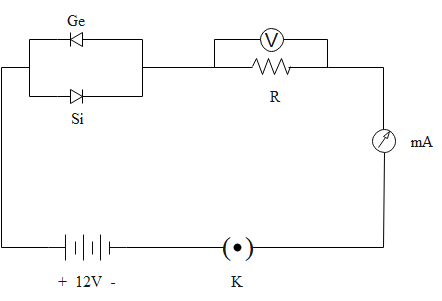Answer
56.1k+ views
Hint: We know that diode (PN junction) in an electrical circuit allows current to flow more easily in one direction than another. Forward biasing means putting a voltage across a diode that allows current to flow easily, while reverse biasing means putting a voltage across a diode in the opposite direction. The Forward bias decreases the resistance of the diode whereas the reversed bias increases the resistance of the diode. In forward biasing the current is easily flowing through the circuit whereas reverse bias does not allow the current to flow through it.
Complete step by step answer
We know that forward bias or biasing is where the external voltage is delivered across the P-N junction diode. In a forward bias setup, the P-side of the diode is attached to the positive terminal and N-side is fixed to the negative side of the battery.
Reverse biased diode means that the positive end of the battery is connected to the negative end of the diode and the negative end of the battery is connected to the positive end of the diode. A diode is an electrical component acting as a one-way valve for current. When voltage is applied across a diode in such a way that the diode allows current, the diode is said to be forward-biased.
The germanium diode is reverse biased and the silicon diode is forward biased. Therefore, there will be no current in the branch of germanium diode. The potential barrier of silicon diode is $0.7 \mathrm{V}$. Therefore, for conduction minimum potential difference across silicon is $0.7 \mathrm{V}$.
Maximum potential difference across resistance, $\mathrm{R}=12-0.7=$$11.3 \mathrm{V}$
So, the correct answer is option B.
Note: The forward bias causes a force on the electrons pushing them from the N side toward the P side. With forward bias, the depletion region is narrow enough that electrons can cross the junction and inject into the p-type material. The width of the depletion layer in a p-n junction diode decreases in forward bias due to repulsion of carriers from battery terminals, holes from p-type and electrons from n-type. Now, due to the small number of ions in the depletion region its potential decreases. Due to this increased depletion width and barrier potential, no charge carriers have the energy to cross the junction so no current flows across the diode. If two diodes are connected in parallel, both forward biased, then current flows through the diode having lesser barrier potential.
Complete step by step answer
We know that forward bias or biasing is where the external voltage is delivered across the P-N junction diode. In a forward bias setup, the P-side of the diode is attached to the positive terminal and N-side is fixed to the negative side of the battery.
Reverse biased diode means that the positive end of the battery is connected to the negative end of the diode and the negative end of the battery is connected to the positive end of the diode. A diode is an electrical component acting as a one-way valve for current. When voltage is applied across a diode in such a way that the diode allows current, the diode is said to be forward-biased.
The germanium diode is reverse biased and the silicon diode is forward biased. Therefore, there will be no current in the branch of germanium diode. The potential barrier of silicon diode is $0.7 \mathrm{V}$. Therefore, for conduction minimum potential difference across silicon is $0.7 \mathrm{V}$.
Maximum potential difference across resistance, $\mathrm{R}=12-0.7=$$11.3 \mathrm{V}$
So, the correct answer is option B.
Note: The forward bias causes a force on the electrons pushing them from the N side toward the P side. With forward bias, the depletion region is narrow enough that electrons can cross the junction and inject into the p-type material. The width of the depletion layer in a p-n junction diode decreases in forward bias due to repulsion of carriers from battery terminals, holes from p-type and electrons from n-type. Now, due to the small number of ions in the depletion region its potential decreases. Due to this increased depletion width and barrier potential, no charge carriers have the energy to cross the junction so no current flows across the diode. If two diodes are connected in parallel, both forward biased, then current flows through the diode having lesser barrier potential.
Recently Updated Pages
Write a composition in approximately 450 500 words class 10 english JEE_Main

Arrange the sentences P Q R between S1 and S5 such class 10 english JEE_Main

What is the common property of the oxides CONO and class 10 chemistry JEE_Main

What happens when dilute hydrochloric acid is added class 10 chemistry JEE_Main

If four points A63B 35C4 2 and Dx3x are given in such class 10 maths JEE_Main

The area of square inscribed in a circle of diameter class 10 maths JEE_Main

Other Pages
If a wire of resistance R is stretched to double of class 12 physics JEE_Main

Electric field due to uniformly charged sphere class 12 physics JEE_Main

Which of the following is not a redox reaction A CaCO3 class 11 chemistry JEE_Main

The resultant of vec A and vec B is perpendicular to class 11 physics JEE_Main

Which of the following Compounds does not exhibit tautomerism class 11 chemistry JEE_Main

N2 + 3H2 to 2NH3 Molecular weights of NH3 and N2 are class 11 chemistry JEE_Main




